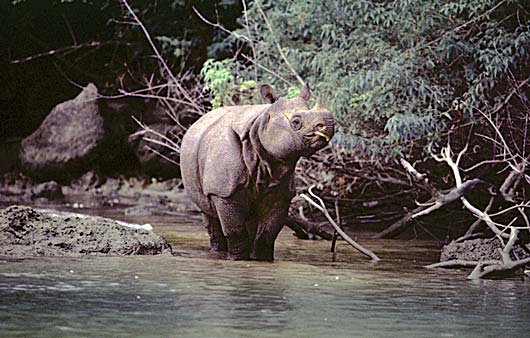

Sounds and calls: Javan rhinos are not very vocal, much less than Sumatran rhinos, and only few vocalisations have been recorded. The visual marks made by the Sumatran rhinos in the form of twisted saplings are also unknown in Javan rhinos They drag a hind foot, sometimes for several metres, to mark the scratch with the secretions of the foot glands. Unlike Sumatran rhinos, Javan rhinos do not scratch their hind feet in the dung and kick it around in the bushes. Scent marking: Dung heaps serve as a communication point, though the large latrines common in the greater one-horned rhino do not occur, probably because of the much lower natural density of these animals. Mating and courtship: There is a short period of courtship around the time when a female is in oestrus and this is generally the only time adult males and adult female socialise. There is no indication that these territories are actually defended by territorial fights as happens in other rhino species, but they are marked along the main trails by urine, faeces, scrapes and twisted saplings.įemale territory: The ranges of the females in Ujung Kulon are much smaller (3-14 km2) and overlap each other considerably. Male territory: Males in Ujung Kulon have larger territories (12-20 km2), only marginally overlapping with other males territories. Occasionally young animals may form pairs or small groups for some time. Sociability: Javan rhinos are usually solitary, except for females with small calves, or during courtship.
Javan rhinoceros diet skin#
The skin is covered with a mosaic pattern, giving a scale-like appearance. The neck folds are less massive than in the greater one-horned rhino, but two folds continue over the back of the neck, forming a characteristic “saddle” on the neck-shoulder. As for the other Asian rhinos, there are two folds in the skin circling the body behind the front legs and before the hind legs, and horizontal folds at the base of the legs. Such prehensile lips are found in all browsing rhino species: the African black rhino, and the greater one-horned and Sumatran rhinos. Attacks on humans are not uncommon when the Javan rhino is met in the forest.ĭistinctive characteristics: Javan rhinos have long pointed upper lip, which assists in grasping their food. Senses: Javan rhinos have a good sense of smelling and hear very well, but are rather short sighted. Over the years the teeth wear down by several centimetres to become shallow and dish-like, and making it difficult for older rhinos to break down their food. The ridges of enamel on these teeth are used to cut up the woody parts of their food into characteristic 1-2cm long pieces. Javan rhinos also have two rows of 6 strong, braod and low-crowned molars on each side. These are used in fighting and can inflict deep wounds. Teeth: Like all Asian rhinos, Javan rhinos have long, sharp, dagger-shaped lower incisor teeth. It is not used for fighting, but for scraping mud from the sides of wallows, pulling down food plants, and for protection of the head and nose when breaking through dense vegetation Rhino horn has the same horn structure as the hooves of horses and re-grows if broken off. The longest horn ever recorded is only about 27 cm long and is now in the British Museum in London.

Males have larger horns and many females, especially in Ujung Kulon, have no horn or just have a small knob on the nose.

The horn: Javan rhinos have a single horn, grey or brownish in colour, usually less than 20 cm long. Skin colour: Javan rhinos have grey or grey-brown skin, almost black when wet, with pink colouring in the folds. Lifespan: Javan rhinos are estimated to live an average of 35 to 40 years in the wild. They typically range between 900 and 2,300 kg. Weight: Javan rhinos are comparable in size to the African black rhino, though only a few animals have actually been weighed. There is not much difference in size between the males and females, and from information gathered in Ujung Kulon and from museum skeletons, there is a possibility that females are slightly bigger. It stands at 1.4 to 1.7 metres tall at the shoulder. Size: The Javan rhino is a smaller and lighter relative of the greater one-horned rhino. Sondaicus derives from “Sunda,” the name for the western part of Java, but the word is also used to indicate the main chain of Indonesian islands, the “Sunda islands” ▪ Scientific name: Rhinoceros sondaicus from the Greek “rhino”, meaning “nose” and “ceros” meaning “horn”. (This information was originally put together by Nico van Strien, in 2005 population figures have been updated as at March 2012.) The Javan rhino is possibly the rarest large mammal on earth.


 0 kommentar(er)
0 kommentar(er)
